Art Lagnuage Puppet Characters Animals Colors Shapes Sounds Science Nature and More
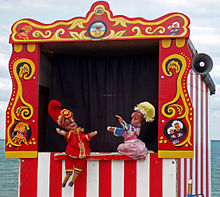

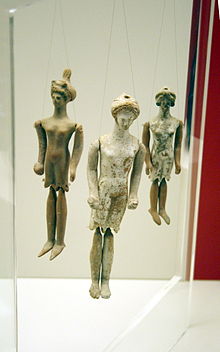
A puppet is an object, oft resembling a human being, animal or mythical effigy, that is animated or manipulated past a person chosen a puppeteer. The puppeteer uses movements of their easily, arms, or control devices such as rods or strings to move the body, head, limbs, and in some cases the mouth and eyes of the puppet. The puppeteer often speaks in the voice of the character of the boob, and then synchronizes the movements of the puppet'south mouth with this spoken part. The deportment, gestures and spoken parts acted out by the puppeteer with the puppet are typically used in storytelling. Puppetry is a very ancient form of theatre which dates back to the 5th century BC in Ancient Greece. There are many different varieties of puppets, and they are fabricated from a wide range of materials, depending on their form and intended apply. They range from very simple in construction and operation to very complex.
Two simple types of puppets are the finger puppet, which is a tiny puppet that fits onto a single finger, and the sock puppet, which is formed and operated by inserting one'due south hand inside a sock, with the opening and closing of the mitt simulating the motion of the puppet'southward "mouth." The sock puppet is a type of hand puppet, which is controlled using i mitt that occupies the interior of the puppet and moves the boob around. A "live-hand puppet" is similar to a hand puppet simply is larger and requires two puppeteers for each puppet. A Marionette is a much more complicated type of puppet that is suspended and controlled by a number of strings connected to the caput, back and limbs, plus sometimes a central rod attached to a command bar held from above by the puppeteer.
A rod puppet is constructed around a central rod secured to the head. A shadow puppet is a cutting-out figure held between a source of light and a translucent screen. Bunraku puppets are a type of Japanese wood-carved boob. A ventriloquist's dummy is a puppet, often man-shaped, operated by a ventriloquist performer'southward hand; the performer produces the puppet's phonation with little or no movement of her mouth, which creates the illusion that the puppet is live. Funfair puppets are big puppets, typically bigger than a human being, designed to be part of a large spectacle or parade.
Origins [edit]
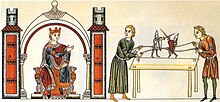
Medieval knight puppets do battle in the Hortus deliciarum. Each boob is manipulated past both puppeteers.
Puppetry was practiced in Ancient Greece and the oldest written records of puppetry can be found in the works of Herodotus and Xenophon, dating from the 5th century BC.[1] [two] The Greek word translated as "boob" is "νευρόσπαστος" (nevrospastos), which literally means "drawn by strings, string-pulling",[3] from "νεῦρον" (nevron), meaning either "sinew, tendon, muscle, string", or "wire",[4] and "σπάω" (spaō), meaning "draw, pull".[v] [6]
Aristotle (384–322 BC) discusses puppets in his work On the Motion of Animals.
The movements of animals may be compared with those of automatic puppets, which are set going on the occasion of a tiny movement; the levers are released, and strike the twisted strings against one another.[7]
In India, puppetry was practiced from ancient times and is known by unlike names in different parts of the land. Excavation of clay dolls from Indus valley sites serve as an indication.[8] The fine art of puppetry called Bommalattam is mentioned in Tamil literature Silappadikaram, which is written around 2d century B.C.[9]
Types of boob and puppetry [edit]
Puppetry by its nature is a flexible and inventive medium and many puppet companies work with combinations of puppet forms and comprise existent objects into their performances. They might, for example, comprise performing objects such equally torn paper for snow, or a sign board with words every bit narrative devices within a production. The following are, alphabetically, the basic and conventional forms of puppet:
Black lite puppet [edit]

The black low-cal puppet is a form of puppetry where the puppets are operated on a stage lit just with ultraviolet lighting, which hides the puppeteer and accentuates the colours of the puppets, which are unremarkably designed using colours that respond to UV calorie-free past glowing brightly. The puppeteers perform dressed in black against a black background, with the groundwork and puppeteer'southward costume normally fabricated of black velvet. The puppeteers dispense the puppets under the light, while they position themselves unseen against the black unlit background. Puppets of many sizes and types may exist used. The original concept of this course of puppetry can be traced to Bunraku puppetry.
Bunraku puppet [edit]
Bunraku puppets are a blazon of wood-carved puppet originally fabricated to stand out through torch illumination. Adult in Nihon over a thousand years ago and formalised and combined with shamisen music at the finish of the 16th century, the puppeteers clothes to remain neutral confronting a blackness background, although their presence as a kind of 'shadow' effigy adds a mysterious power to the puppet. Bunraku traditionally uses three puppeteers to operate a puppet that varies from 1/3 to 1/two life size.[10]
Cantastoria [edit]
Cantastoria is a class of visual storytelling in which a puppet, illustration, painting, or other visual medium is accompanied by rhythmical speech or song that describes or reenacts events to tell a story.
Carnival/Body Puppets [edit]
Carnival puppets (too known every bit body puppets) are commonly designed to be part of a big spectacle. These are often used in parades (such equally the Mayday parade in Minneapolis, U.s.a. and The Cape Boondocks Carnival in South Africa) and demonstrations, and are at least the size of a human and oftentimes much larger. One or more performers are required to move the body and limbs. In parades, the appearance and personality of the person within is not relevant to the spectator. These puppets are particularly associated with large-scale entertainment, such as the nightly parades at various Disney complexes around the world. Similar puppets were designed by Julie Taymor for The Lion Rex.
The Jim Henson Visitor also has their version of these puppets chosen full-bodied puppets. The Sesame Street characters Big Bird and Mr. Snuffleupagus, as well as the titular graphic symbol from Acquit in the Large Blueish House, are pop examples of this type of puppet (Snuffleupagus, in detail, requires two puppeteers; one in the front of the boob, and i in the back).
The Little Girl Giant Puppet is an initiative by the MJF Charitable Foundation to promote Puppetry and to spread the message of female person empowerment in Sri Lanka. This giant puppet measured 14 ft and was built under the management of Swedish artist Felix Widen Norgren (Director, Compania Pirata) in collaboration with Power of Play PVT LTD, Sri Lanka.

The Little Girl Giant Puppet in Sri Lanka was a novel initiative to educate on female person empowerment.
Finger boob [edit]
The finger puppet is a simple puppet variant which fits onto a single finger. Finger puppets normally take no moving parts, and consist primarily of a hollow cylinder shape to cover the finger. Finger puppets are often decorated with eyes and mouths made out of fabric or other materials. This form of puppet has express application, and is used mainly in pre-schools or kindergartens for storytelling with young children.
Hand puppet or glove puppet [edit]
A hand puppet (or glove boob) is a puppet controlled by one manus, which occupies the interior of the puppet. The Punch and Judy puppets are familiar examples of hand puppets. Larger varieties of hand puppets place the puppeteer's hand in only the puppet'south caput, controlling the rima oris and head, and the puppet'due south body then hangs over the unabridged arm. Other parts of the boob (mainly arms) are commonly not much larger than the manus itself. Often the mouth can also open and shut, and special variants exist with eyelids that can be manipulated. A sock boob is a particularly simple blazon of hand puppet made from a sock.[xi]
Homo-arm puppet [edit]
Also called a "two-man boob" or a "live-hand puppet", the human being-arm boob is like to a hand puppet but is larger and requires ii puppeteers. One puppeteer places their dominant paw inside the puppet's head and operates the puppet'south head and mouth, while putting their non-dominant arm into a glove and special sleeve attached to the puppet. The 2nd puppeteer puts their arm into a glove and special sleeve attached to the boob in order to operate the other arm. This way, the puppet tin can perform hand gestures. This is a form of glove or hand puppetry and rod puppetry.
Some of Jim Henson's Muppets, such as the Muppet character Fozzie Bear and the Sesame Street characters Ernie and Count von Count, are live-hand puppets. A variation of this puppet, called a "sack-body" puppet, is congenital with the puppet's arms direct connected to its base. Popular examples include the Sesame Street characters Cookie Monster and Oscar the Grouch, and the Muppet grapheme Rowlf the Dog. The Swedish Chef, another Muppet character, is operated in a unique mode; both of his easily are actual human easily, supplied by the second performer. The technique of the main puppeteer performing a character's caput with an assistant performing both arms is also used for Rowlf playing the piano.
-

"Chili das Schaf" puppet and creators Tommy Krappweis and Erik Haffner, taken at "Erstes Fantreffen von Bernd das Brot"
-

Lite drapery puppet [edit]
Light curtain boob presentations employ light to highlight small portions of a performance area, assuasive the puppet to be seen while the manipulators remain invisible. The puppets stand on a phase divided into an unlit groundwork and a well-lit foreground, meeting to form a "pall" of light. The puppeteer dresses in black and remains subconscious in the unlit background of the phase while the puppet is held across the light mantle in the lit foreground of the stage. "Light curtain boob" is an umbrella term, and any puppet which is extended into a well-lit area where its handler remains separated from the puppet by a division of light may be called a low-cal mantle puppet.[12]
Marionette [edit]
Marionettes, or "string puppets", are suspended and controlled past a number of strings, plus sometimes a primal rod attached to a control bar held from to a higher place by the puppeteer. The control bar can exist either horizontal or vertical. Bones strings for operation are normally fastened to the head, back, hands (to control the artillery) and just above the human knee (to command the legs).[13] This form of puppetry is complex and sophisticated to operate, requiring greater manipulative control than a finger, glove or rod puppet. The puppet play performed by the Von Trapp children with Maria in The Sound of Music is a marionette show.
-
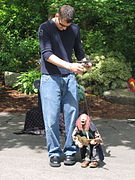
-
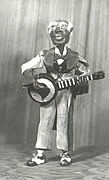
"Uncle Rastus" an elderly homo playing a banjo
-

Prominent marionette theaters operating today include: Salzberg Marionette Theater, Bob Baker Marionette Theater, Center for Puppetry Arts, Melchior Marionette Theater, the Swedish Cottage Marionette Theatre in Central Park, New York, and Le Theatre de Marionette.
Marotte [edit]
The marotte is a simplified rod puppet that is but a caput and/or body on a stick. It was used by jesters in renaissance times. In a marotte à principal prenante, the puppeteer'south other arm emerges from the torso (which is simply a fabric drape) to act every bit the puppet's arm. Some marottes accept a minor string running through the stick fastened to a handle at the bottom. When the handle is squeezed, the rima oris opens.
Motekar [edit]
Motekar or wayang motekar is a kind of shadow puppet theater known in Sundanese, Javanese, and Indonesian equally 'wayang (kulit)', that is, (leather) shadow puppet. While near shadow puppets cast black silhouettes from behind a screen, motekar shadow puppets can exist in full colour. They use plastic materials, transparent dyes, a special light arrangement, and a special blazon of screen to make this happen. Motekar puppet shows can exist performed by i or several puppeteers and usually feature music, singing, and a series of dances.
Object puppet [edit]

Non all forms of puppetry need specially created items to boob. Object puppets tin can be created with found everyday objects either assembled in advance or during operation. Señor Wences was a Castilian ventriloquist who became popular through his appearances on the American program The Ed Sullivan Testify. His characters included Johnny (a face drawn on his mitt) and Pedro (a gruff head in a box) who would talk when Wences opened the box. Similarly, chinface puppetry involves boob features drawn or fastened onto an upside-down chin.
Pull string puppet [edit]
A pull cord puppet is a puppet consisting of a textile body where in the puppeteer puts his/her arm into a slot in the back and pulls rings on strings to brand sure movements such as waving the artillery or moving the mouth.
Push puppet [edit]
A push button puppet consists of a segmented grapheme on a base which is kept under tension until the button on the bottom is pressed. The puppet wiggles, slumps then collapses. Push puppets are usually intended as novelty toys, rather than as part of professional person puppet theatre.
Rod boob [edit]
A rod puppet is a puppet constructed around a central rod secured to the head. A big glove covers the rod and is fastened to the neck of the puppet. A rod puppet is controlled past the puppeteer moving the metal rods fastened to the easily of the puppet (or whatsoever other limbs) and by turning the central rod secured to the head. The all-time known examples of rod puppets are Jim Henson's Muppets, most notably Muppet characters such as Kermit the Frog, Miss Piggy, Gonzo and others, many Sesame Street characters such every bit Elmo, Bert, Grover and Abby Cadabby, and the main cast of Fraggle Rock.
-
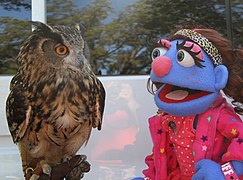
Rod puppet "Bleeckie", coming together an owl, 2011.
Shadow puppet [edit]
A shadow boob is a cut-out figure held betwixt a source of lite and a translucent screen. Shadow puppets tin can course solid silhouettes or be decorated with various amounts of cutting-out details. Color can be introduced into the cut-out shapes to provide a dissimilar dimension and different furnishings can be achieved by moving the boob (or light source) out of focus. Javanese shadow puppets known equally Wayang Kulit are the classic example of this.[fourteen] In China, information technology became pop from Song Dynasty.[fifteen]
Sock boob [edit]

Sock puppet from the Web series Totally Socks
A sock boob is a puppet formed and operated by inserting a hand inside a sock. The manus is opened and airtight to simulate the movement of the boob's "rima oris" and give the impression of speaking. Sometimes eyes and other facial features are added to the sock in order to make the boob more than realistic. Sock puppets are popular in many puppet performances, as they are simple to make and easy to use. They are mostly used in satirical or children'southward works.
Supermarionation [edit]
Supermarionation is a method of puppetry invented by Gerry Anderson, which he used in his television shows Stingray and Thunderbirds. The puppets were marionettes with electronically moving mouths to let for lip-synchronised speech. The marionettes were notwithstanding controlled past human manipulators with darkened strings.
Tabular array top puppet [edit]
A table top puppet is a puppet unremarkably operated by rod or directly contact from behind, on a surface similar to a table top (hence the proper name). Shares many characteristics with Bunraku.
Ticklebug [edit]
A Ticklebug is a type of mitt boob created from a human mitt to accept four legs, where the puppet features are fatigued on the mitt itself. The heart finger is lifted as a head, and the thumb and forefinger serve every bit a first set of two legs on one side, while the ring finger and pinkie serve equally a second set of two legs on the reverse side.[ citation needed ]
Toy theatre [edit]
The toy theatre is a boob cut out of paper and stuck onto card. It is stock-still at its base to a stick and operated by pushing it in from the side of the boob theatre. Sheets of puppets and scenery were produced from the 19th century for children's use.
Ventriloquism dummy [edit]
The Ventriloquist's Dummy is a boob shaped like a modest human which is operated past a ventriloquist performer to focus the audition'south attention away from the performer'southward activities and heighten the illusion that the dummy is speaking. They are called dummies because they do non speak on their ain. The ventriloquist dummy is controlled past 1 mitt of the ventriloquist. Ventriloquism acts are non always performed with a traditional dummy; occasionally other forms of puppetry are used.
-
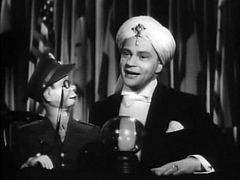
Edgar Bergen, seen with Charlie McCarthy, is one of America'southward best known puppeteers.
-

Ventriloquist Ramdas Padhye has been performing in India for over xl years.
-
Performers like Jeff Dunham, here with Achmed the Dead Terrorist, accept revived involvement in North America.
-

High german Jörg Jará's puppet, Olga.
-

British Nina Conti with Monkey in 2010
H2o boob [edit]

A water boob is a Vietnamese puppet form, the "Múa rối nước". Múa rối nước literally translates to "dance underwater" or "dancing underwater". This is an ancient tradition that dates back to the 10th century. The puppets are congenital out of wood and the shows are performed in a waist-deep pool. A large rod supports the puppet under the water and is used by the puppeteers to command them. The appearance is of the puppets moving over the water. When the rice fields would flood, the villagers would entertain each other using this boob form.
The water also provides the setting for traditional stories depicting day-to-mean solar day village life. H2o puppets bring wry sense of humor to scenes of farming, line-fishing, festival events such every bit buffalo fights, and children's games of marbles and coin-toss. Fishing turns into a game of wits between the fisherman and his prey, with the fisherman getting the short finish (oftentimes capturing his surprised neighbour by mistake). Besides village life, scenes include legends and national history. Lion dogs romp similar puppies while dragons exhale fire and smoke and shoot sprays of h2o at the audience. Performances of up to eighteen curt scenes are usually introduced past a pig-tailed bumpkin known equally Teu, and accompanied by a small-scale folk orchestra.[16]
Rajasthani Puppet [edit]
Painted wooden heads, easily made simply by stuffing dress or cotton into the sleeve of the dress, with painted appearances, angled eyebrows, mustache for men and nose ring for ladies and huge expressive eyes all over, manikins are hung with dresses produced using sequined quondam textures.[ citation needed ]
Idioms and cultural expressions [edit]
The give-and-take boob can mean a political leader installed, supported and controlled by powerful external forces, without legitimacy in the country itself. In mod times, this usually implies no democratic mandate from the country'south electorate; in before times, it could take meant a monarch imposed from exterior, who was not a member of a land'due south established ruling dynasty, or unrecognised past its dignity. "Puppet government", "puppet regime" and "boob country" are derogatory terms for a government which is in charge of a region or country, merely only through existence installed, supported and controlled by a more powerful exterior government. An case is Vidkun Quisling, a Norwegian fascist leader during Earth State of war 2 who collaborated with the Nazis and led a puppet government.
In a more full general sense, a puppet is any person who is controlled by another by reasons of (for case) undue influence, intellectual deficiency, or lack of character or charisma. Science fiction writer Robert A. Heinlein'due south novel The Puppet Masters depicts alien parasites who attach themselves to human beings and command their actions.
Poppet, a give-and-take that sounds similar, is sometimes a term of endearment, similar to "beloved", "pet", "doll" or "dear". Information technology alludes to folk-magic and witchcraft, where a poppet is a special doll created to represent a person for the purpose of casting healing, fertility, or binding spells.
Sock boob is used on social media equally a term to describe fake accounts used to spread political disinformation.
Encounter also [edit]
| | Look up boob in Wiktionary, the free dictionary. |
- List of highest grossing boob films
- Animation
- Das Spielhaus - East High german puppet-based TV plan
- Digital puppetry
- Jumping jack (toy)
- Karakuri ningyō - Mechanized puppets or automata from Japan
- Kenya Constitute of Puppet Theatre (KIPT)
- Lübeck Museum of Theatre Puppets
- The Muppets, a cast of puppets from an American TV serial.
- Pelham puppets
- Farsi theatre
- Pierieliepiepielo
- Punch and Judy
- Puppetry
- Ventriloquist
- Ventriloquism
- Rajasthani Puppet - String marionettes originating from the state of Rajasthan in India
- Supermarionation - Advanced cord puppetry techniques utilized in productions by AP Films
- Country Boob Theatre of Fairy Tales
References [edit]
- ^ Herodotus, The Histories, 2.48, on Perseus
- ^ Xenophon, Symposium, 4.55, on Perseus
- ^ νευρόσπαστος, Henry George Liddell, Robert Scott, A Greek-English Lexicon, on Perseus
- ^ νεῦρον, Henry George Liddell, Robert Scott, A Greek-English Lexicon, on Perseus
- ^ σπάω, Henry George Liddell, Robert Scott, A Greek-English language Lexicon, on Perseus
- ^ List of Aboriginal Greek words related to puppetry, Henry George Liddell, Robert Scott, A Greek-English Lexicon, on Perseus
- ^ Aristotle, On the Motion of Animals, 350 BC.
- ^ Srinivasan, Grand. (17 Baronial 2012). "Pulling the strings to resuscitate a dying art". The Hindu. Thanjavur, India.
- ^ "Boob Forms of India". Centre for Cultural Resources and Preparation, Ministry of Culture, Government of Republic of india. Archived from the original on 15 May 2013. Retrieved 24 June 2013.
- ^ Adachi, Barbara C., Backstage at Bunraku, Weatherhill, 1985 . ISBN 0-8348-0199-Ten
- ^ Currell, David, Introduction to Puppets and Puppet making, p.7
- ^ "Puppet show at PNCA mesmerises children of twin cities". Daily Times. Islamabad, Islamic republic of pakistan. five July 2011.
- ^ Robinson, Patricia and Stuart, Exploring Puppetry, p.64
- ^ Currell, David, An Introduction to Puppets and Puppetmaking', p.7
- ^ Tytti Ollila (2 April 2012). "Shadow puppetry brightens those dark days". GB-Times. Archived from the original on July xviii, 2012. Retrieved 24 June 2013.
- ^ Taylor, David (September 18, 1995). "Vietnamese Water Puppets". www.sagecraft.com.
- Ghosh, S. and Banerjee, Utpal Kumar, Indian Puppets, Abhinav Publications, 2006. ISBN 81-7017-435-X.
- Bong, John, Strings, Hands, Shadows: A Modern Puppet History, Wayne State University Press, 2000. ISBN 0-89558-156-6.
Books and articles [edit]
| | Wikimedia Eatables has media related to Puppets. |
- Baird, Bil (1966). The Art of the Puppet. Plays. ISBN0-8238-0067-nine.
- Beaton, Mabel; Les Beaton (1948). Marionettes: A Hobby for Anybody. New York.
- Bell, John (2000). Strings, Hands, Shadows: A Mod Puppet History. Detroit, Usa: Detroit Institute of Art. ISBN0-89558-156-six.
- Binyon, Helen (1966). Puppetry Today. London: Studio Vista Limited.
- Choe, Sang-su (1961). A Written report of the Korean Puppet Play. The Korean Books Publishing Company Ltd.
- Currell, David (1985). The Complete Volume of Puppetry. London: A & C Black (Publishers) Ltd. ISBN0-7136-2429-9.
- Currell, David (1992). An Introduction to Puppets and Puppetmaking. London: New Burlington Books, Quintet Publishing Limited. ISBN1-85348-389-3.
- Dubska, Alice; Jan Novak; Nina Malikova; Marie Zdenkova (2006). Czech Boob Theatre. Prague: Theatre Plant. ISBN80-7008-199-6.
- Dugan, Eastward.A. (1990). Emotions in Move. Montreal, Canada: Galerie Amrad. ISBN0-9693081-v-9.
- Feeney, John (1999). Boob. Saudi Aramco World.
- Bloom, Cedric; Alan Fortney (1983). Puppets: Methods and Materials. Worcester, Massachusetts: Davis Publications, Inc.
- Gross, Kenneth (2011). Puppet: An Essay on Uncanny Life. Chicago: University of Chicago Press. ISBN978-0-226-30958-3.
- Latshaw, George (2000). The Complete Volume of Puppetry. London: Dover Publications. ISBN978-0-486-40952-viii.
- Lindsay, Hilaire (1976). The Kickoff Puppet Volume. Leichhardt, NSW, Australia: Ansay Pty Ltd. ISBN0-909245-06-1.
- Logan, David (2007). Puppetry. Brisbane, QLD, Australia: Brisbane Dramatic Arts Co. ISBN978-0-9804563-0-1.
- Mulholland, John (1961). Practical Puppetry. London: Herbert Jenkins Ltd.
- Richmond, Arthur (1950). Remo Bufano's Book of Puppetry . New York: The Macmillan Company.
- Robinson, Stuart; Patricia Robertson (1967). Exploring Puppetry. London: Mills & Boon Limited.
- Rump, Nan (1996). Puppets and Masks: Stagecraft and Storytelling . Worcester, Massachusetts: Davis Publications. ISBN9780871922984.
- Sinclair, Anita (1995). The Puppetry Handbook. Richmond, Victoria, Australia: Richard Lee Publishing. ISBN0-646-39063-5.
- Suib, Leonard; Muriel Broadman (1975). Marionettes Onstage!. New York: Harper & Row, Publishers. ISBN0-06-014166-2.
Source: https://en.wikipedia.org/wiki/Puppet

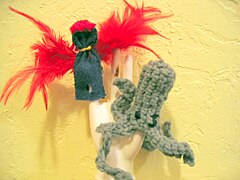
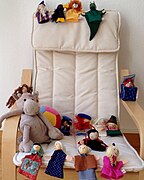

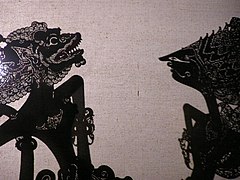

0 Response to "Art Lagnuage Puppet Characters Animals Colors Shapes Sounds Science Nature and More"
Post a Comment